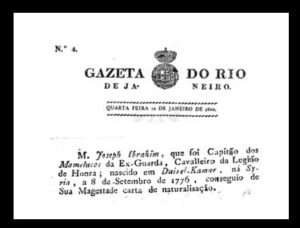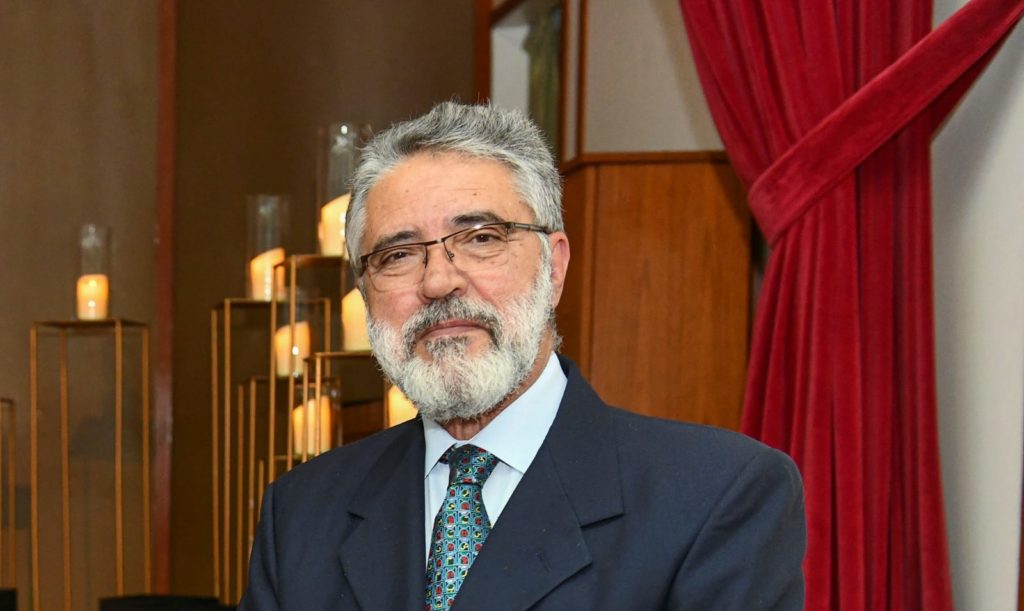By Roberto Khatlab*
As many Mount Lebanon natives did after him, Joseph Ibrahim Nehmé left his lands for Rio de Janeiro in the late 18th century. In contrast, Lebanese-Brazilian Jacob Menassa made the return journey to his country of origin, Lebanon, in the early 19th century, after living in Brazil. At the time, Lebanon, in the geography of the Ottoman Empire, was the mountain range of Mount Lebanon. These two men, Joseph and Jacob, are among the first who made the immigration and return from expatriation movement between Brazil and Lebanon, according to research based on records. Emigration dates back thousands of years in Lebanon’s history and happened for reasons ranging from conflicts to economic, social, and demographic crises. Thus, the book of Mahjar (emigration in Arabic) has not closed its pages for centuries.

The traces of a Lebanese in Brazil in the 18th century, Joseph Ibrahim Nehmé, were an outstanding, unprecedented finding in my research on Arab immigration to Brazil. I found the record in the book of the Brazilian researcher of Syrian-Lebanese descent, the late João Abdalla Neto, who died in 2022. It was a facsimile of a clipping from the official federal gazette of Brazil at the time, Gazeta do Rio de Janeiro, from 1820, about Joseph’s naturalization. “Mr. Joseph Ibrahim, who was captain of the Mamluks of the Former Guard, knight of the Legion of Honor; born in Dair el Kamar, in [sic] Syria, on September 8, 1776, obtained a letter of naturalization from His Majesty,” says the excerpt.
Based on this facsimile and in conversations with researcher João Abdalla Neto, I began to analyze and research the text in the newspaper to find out more about Joseph. Joseph Ibrahim’s last name is not written in the newspaper, but Joseph is in French, as France has links with Christians in Mount Lebanon since the 13th century, and many have adopted a French name. It also appears in the paper the family name Ibrahim, Joseph’s father’s first name, which is common in Arab countries. Joseph Ibrahim Nehmé’s surname was not registered in Portuguese documents – Joseph went to Portugal before living in Brazil.
Joseph was, in Brazil, captain of the Mamluks of the Former Guard. Mamelukes is the name given in Brazil to European-Amerindian mestizos. The term was used for organized groups of slave hunters, also known as Bandeirantes, who roamed the interior of Brazil in search of precious metals. Joseph was captain of a group of Bandeirantes. He was so committed to his position he received medals such as knight of the Legion of Honor.
The newspaper reported Joseph was born in Deir El-Kamar, Syria. In fact, Deir El-Kamar was at the time the capital of the Emirate of Mount Lebanon (1516-1849), one of the autonomous provinces within the Ottoman Empire, which had two ruling dynastic clans: Maan (Fakhreddine) and Chehab. Today Deir El-Kamar is a historic town in Chouf District, Mount Lebanon Province. Joseph was born on September 8, 1776, under the rule of Emir Youssef Chehab. He received naturalization in 1820, two years before the Independence of Brazil, from His Majesty Dom João VI, who at the time was King of the United Kingdom of Portugal, Brazil, and the Algarves (1815-1822).

What was Joseph Ibrahim’s last name? In Lebanon, I started research in collaboration with the Lebanese-Brazilian genealogical researcher Ramez Toufic Labaki from the city of Deir El-Kamar, where Joseph Ibrahim was born, 38 kilometers away from Beirut. In this research, we found several families in the city, such as Chamoun, Rizkallah, and Richa, and the surprise was to find a family tree in Arabic with the name Joseph. It was actually spelled Joseph, not Youssef, as it would be in Arabic. The tree states Joseph was the son of Ibrahim, from the family surnamed Nehmé. The word Nehmé or Nahmé means “blessing” in Arabic. Therefore, the immigrant’s full name was Joseph Ibrahim Nehmé, from a large family in Deir El-Kamar and which, in principle, originates from the Daou family tree.
And it is believed the root of the name is from the city of Lehfed, near Byblos, Mount Lebanon. The surname Nehmé comes from Christian families of the Maronite Catholic Church. This is the case with Joseph, but Muslim, Sunni, Shia, and Druze families share the same surname. Among Maronite Christians are Blessed Estefano Nehmé (1889-1938) from Lehfed. In the family tree we found in Deir El-Kamar, there are some names from the year 1600. The tree was made by Nehmé Bechara Nehmé (1913).
With this information, I began to analyze the historical moment of the 18th century in Deir El-Kamar and the problem of population mobility in an attempt to outline an epistemological framework. The emigration of Joseph Ibrahim Nehmé took place around 1795; therefore, the earliest date known to us so far in the history of Lebanese emigration to the New World. At that time, the Emirate of Mount Lebanon had succession problems in the Chehab dynasty of Emir Bachir II Chehab (1788-1840). The conflicts led many young people, just as today, to emigrate from Lebanon. Joseph left for Europe and arrived in Lisbon, Portugal.
He worked in the Portuguese Navy and sailed to Brazil, which at the time was a colony of Portugal. He arrived in Rio de Janeiro in the same year and continued in the Portuguese navy. Then he went on to be a Bandeirante, explorer, and captain of the Mamluks. The Lebanese received decorations and, in 1820, was naturalized as a citizen of the United Kingdom of Portugal, Brazil, and the Algarves. Joseph remained in Rio de Janeiro and worked in commerce. In principle, he married an indigenous woman in Brazil. He died in 1840. Joseph Ibrahim Nehmé can be considered one of the first Lebanese from Mount Lebanon to immigrate to Brazil, in 1795, in the 18th century. He has been one of the landmarks of the Lebanese presence in Brazil for 227 years (1795-2022).
In 1858, the Brazilian – Ottoman Turk Treaty of Friendship, Trade, and Navigation was signed between the Emperor of Brazil, Pedro II of Alcântara, and the Ottoman Sultan Abdulmejid I. The treaty facilitated trade between the empires and the movement of Ottoman Turkish passport holders. It also enabled the flow of Turkish, Arab, Armenian, and Greek merchants to Brazil. In 1871 and 1876, Dom Pedro II visited the Levant, passing through Syria, Mount Lebanon, Palestine, and Egypt. The emperor, knowledgeable about Arabic culture and language, had the Arab newspapers of the time write about his visit and about Brazil, which attracted more Arabs to the South American country. From 1880 onwards, there was a massive immigration of Arabs to Brazilian lands, mainly Lebanese and Syrians. Pedro II pioneered Brazil-Arab World relations and attracted the Arab “Great Immigration” to Brazil.

In this same Lebanese immigration research, I discovered something unprecedented in contact with the Lebanese cultural promoter Jacques Menassa, whose grandfather, Jacob Ibrahim Menassa (1872–1937), born in the city of Ghosta, Mount Lebanon, Ottoman Empire, heard about a Brazilian emperor. Pedro II visited the region of Nahr el Kalb [Dog River], Mount Lebanon, in 1876, and Jacob learned from newspapers and people that Pedro II’s country was great. Jacob Menassa, then, decided to emigrate, with his two brothers, to Manaus, in the Brazilian state of Amazonas, in 1885, during the rubber boom. Jacob worked in commerce well into the so-called “Amazonian Belle Époque” (1890-1920). He was naturalized Brazilian in 1889. But in 1900, Jacob decided to return to Mount Lebanon with his wife, Wadigha Cecin (Sessin), from Tripoli, to trade between Brazil and Mount Lebanon, Ottoman Empire. Thus, Jacob and Wadigha were among the pioneers to return from Brazil to Lebanon and start a community of ‘Brasilebanese’ in the Arab country, a neologism I created for Brazilian-Lebanese binationals. According to this survey, this presence in Lebanon has just reached 122 years (1900-2022).
Both the Lebanese and their descendants in Brazil and the Brazilians in Lebanon are well integrated into the societies in which they live. Both contributed and still contribute to the formation and development of the two countries, which are friends and have century-old ties. Joseph Ibrahim Nehmé and Jacob Ibrahim Menassa are two landmarks of the Brazil-Lebanon friendship. The research continues, and the epic of the Arabs worldwide, and in Brazil, is glorious. The Mahjar book is always open to new discoveries.
Contents from the books’ Limamo – um Herói Brasileiro’ [‘Limamo – A Brazilian hero,’ in free translation], by João Abdalla Neto, published by Schoba, ‘Brasil-Líbano, amizade que desafia a distância’ [‘Brazil-Lebanon, a friendship that defies distance,’ in free translation], by this researcher who writes (Roberto Khatlab), from Edusc and Dar al-Farabi publishing houses, and ‘Mahjar – Saga libanesa no Brasil’ [‘Mahjar – Lebanese saga in Brazil,’ in free translation], also by this researcher, from Mukhtarat publishing were used as references for this article.
Roberto Khatlab is a researcher and writer, director of the Center for Latin American Studies and Cultures at the Holy Spirit University of Kaslik (USEK) in Lebanon, and author of the books ‘As Viagens de D. Pedro II: Oriente Médio e África do Norte, 1871 e 1876’ [‘The Travels of Dom Pedro II: Middle East and North Africa, 1871 & 1876,’ in free translation] and ‘Mahjar – Saga libanesa no Brasil’ [‘Mahjar – Lebanese saga in Brazil’], among others.
Translated by Elúsio Brasileiro




